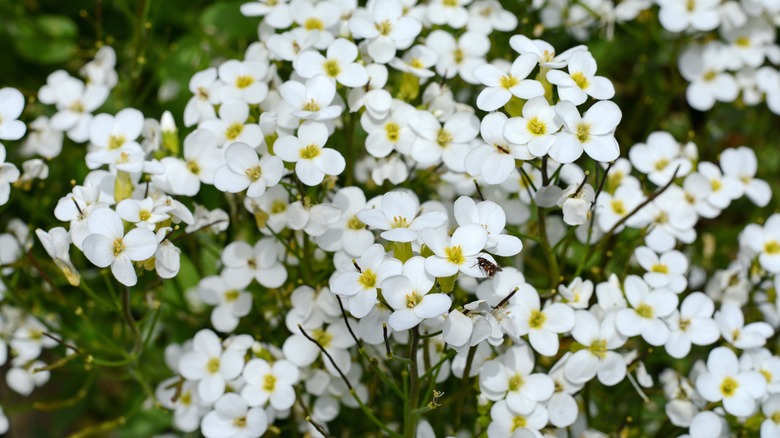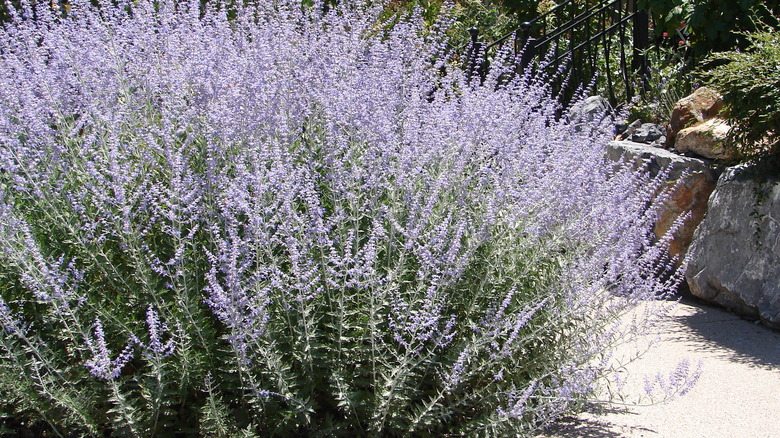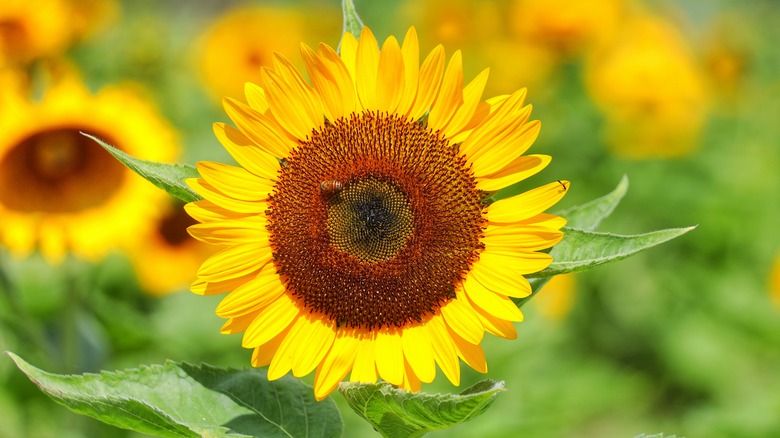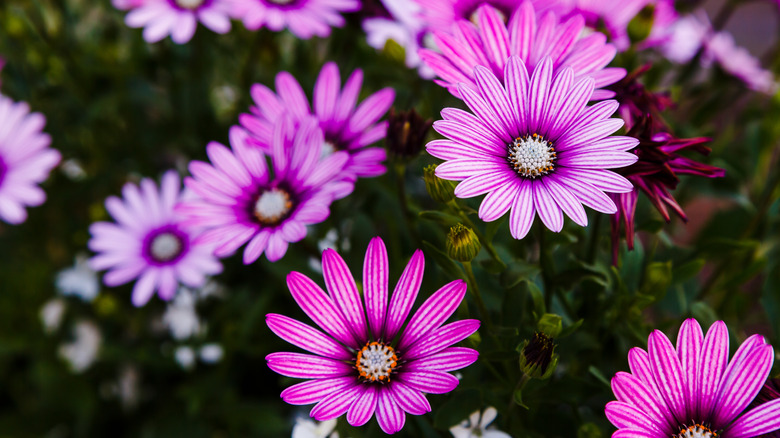Transitioning your spring border garden into one that is still blooming through summer and into autumn can be tricky. In the spring we all love the brightly blossoming crocus and daffodil. However, when you want to make your border garden last through different seasons with limited maintenance, you might have to make some planning decisions. One of the best choices you can make is to include long- and late-blooming flowers. Most often, flowers like petunias, sweet alyssums, and African daisies, will pop up in the spring and last for several months, while others, like phlox and coneflowers, will arrive late and stay bright through fall.
No matter which annuals and perennials you choose, your autumn border garden should reflect you. Costa Farms suggests picking your favorite flowers and combining them with colorful, leafy plants and layering different species of plants for a lush look. Here, we’ve gathered 15 flowers to get you started on this project. Before you plant, always be sure that you can meet your flowers’ requirements for temperature, soil, and sunlight.
1. Floss flower

The floss flower (Ageratum houstonianum) is one of the 43 species in the Ageratum genus, says the University of Wisconsin-Madison. This flower is known for blooming throughout the summer and fall seasons which makes it a great option for a long-lasting border garden.
Bloom Season: Late spring to late fall
USDA Growing Zone: 2 to 11
Growing Conditions: Full sun to part shade
Soil Type: Moist and well-draining
Size: Up to 30 inches tall and 18 inches wide
2. Blanket flower

The blanket flower (Gaillardia spp.) is a member of the daisy family and its flowers reflect that fact. As explained by North Carolina State Extension, the blanket flower produces medium-size red, orange, and yellow blossoms that feature about 7 to 20 petals arranged in a disc shape.
Bloom Season: Summer to fall
USDA Growing Zone: 3 to 9
Growing Conditions: Full sun
Soil Type: Well-draining loam or sand
Size: Up to 24 inches tall and 18 inches wide
3. Sweet alyssum

milart/Shutterstock
Sweet alyssum (Lobularia maritima) is known for its sugary fragrance and long bloom period even in some of the cooler regions of the United States. This plant looks great as ground cover, yet it can be planted in the front of your autumn border garden for a honey-like scent as you walk past it, says the University of Wisconsin-Madison.
Bloom Season: Spring to fall or year-round in warmer regions
USDA Growing Zone: 5 to 9
Growing Conditions: Full sun to partial shade
Soil Type: Well-draining
Size: 3 to 9 inches tall and wide
4. Phlox

krolya25/Shutterstock
Fall phlox (Phlox paniculata) has many species and cultivars that vary greatly in size and color. As explained by Proven Winners, fall phlox or tall garden phlox produces blossoms near the end of summer. Most often these flowers are pink, fragrant, and surrounded by green foliage.
Bloom Season: Summer to fall
USDA Growing Zone: 3 to 8
Growing Conditions: Sun to partial sun
Soil Type: Moist and well-draining
Size: More than 2 feet tall and wide
5. Bidens

P. OCHASANOND/Shutterstock
Bidens (Bidens ferulifolia) are low-maintenance flowers ready to be planted in garden beds, border gardens, or containers, as advised by Costa Farms. Depending on the variety you choose, bidens can be yellow, pink, or white. In most regions, these flowers are annuals, however, they make up for this with an extended bloom time.
Bloom Season: Summer to fall
USDA Growing Zone: 8 to 11
Growing Conditions: Full sun to partial shade
Soil Type: Well-draining
Size: Up to 10 inches tall and wide to 24 inches wide
6. Moss verbena

Paul and Studio/Shutterstock
Per North Carolina State Extension, moss verbena (Verbena aristigera) is a warm-weather-loving, drought-tolerant, and spreading plant that requires full sun. Positioned near the front of an autumn border garden, this blue-purple wonder will look great with complementary yellow flowers such as bidens or blanket flowers.
Bloom Season: Summer to fall
USDA Growing Zone: 8 to 10
Growing Conditions: Full sun
Soil Type: Well-drained loam or sand
Size: 1 foot tall and 6 feet wide
7. Petunia

Defodi Images/Getty Images
Petunias (Petunia spp.), which bloom for several months straight, are known for their many varieties, explains the University of Minnesota Extension. You can find these flowers in almost every color imaginable. This makes them the perfect multi-color addition to a border garden because you can easily find a cultivar that matches the theme you’re going for.
Bloom Season: Spring to early winter
USDA Growing Zone: 10 to 11
Growing Conditions: Full sun
Soil Type: Well-drained
Size: 6 to 15 inches tall
8. Black-eyed Susan

Lana B/Shutterstock
Black-eyed Susans (Rudbeckia hirta) are difficult to kill. These prairie wildflowers will grow in just about any soil and sunlight conditions, and they’re drought tolerant, according to Prairie Nursery. They work in autumn border gardens because their typical yellow and brown flowers are reminiscent of changing leaves and typical fall décor.
Bloom Season: Summer to fall
USDA Growing Zone: 3 to 10
Growing Conditions: Full sun to partial shade
Soil Type: Well-drained clay, loam, or sand
Size: 1 to 3 feet tall
9. Calla lily

Wirestock Creators/Shutterstock
Calla lilies (Zantedeschia rehmannii) grow from rhizomes and should not be planted until well after the last frost has passed, so Longfield Gardens recommends getting them started indoors. Once planted, they’ll shoot up quickly and their blooms will last for about six weeks, which should mean they’re still there when fall arrives.
Bloom Season: Summer to fall
USDA Growing Zone: 8 to 10
Growing Conditions: Bright to medium light
Soil Type: Well-draining
Size: 1 to 2 feet tall
10. Russian sage

Kathryn Roach/Shutterstock
Russian sage (Perovskia atriplicifolia) is an herbaceous perennial from the mint family. Like mint, the leaves of this plant can be crushed. The scent it produces is like a mix of common sage and lavender. Russian sage is also littered with flowers from July to October, per Missouri Botanical Garden. The flowers can be identified by their tiny light blue petals.
Bloom Season: Summer to fall
USDA Growing Zone: 5 to 9
Growing Conditions: Full sun
Soil Type: Well-draining
Size: Up to 5 feet tall and 4 feet wide
11. Sunflower

SIN CHI KIN/Shutterstock
Sunflowers (Helianthus annuus) are a species of tall-growing flowers that are usually yellow, but sometimes orange or maroon, as per the California Native Plant Society. They are adaptable to a range of soils and climates, but they do need full sun in order to flourish.
Bloom Season: Summer to fall
USDA Growing Zone: 2 to 11
Growing Conditions: Full sun
Soil Type: Sand, loam, or clay
Size: 5 to 10 feet tall and 2 feet wide
12. African daisy

Greens and Blues/Shutterstock
The African daisy (Osteospermum jucundum) is native to southern Africa and the Arabian peninsula. These purple to white daisy-like blossoms last throughout the summer and fall, explains the Royal Horticultural Society. African daisies do well in border gardens along with other colorful flowers that enjoy full sun and well-draining soil.
Bloom Season: Summer to fall
USDA Growing Zone: 10 to 11
Growing Conditions: Full sun
Soil Type: Well-draining sand, loam, or clay
Size: 4 to 20 inches tall and 20 to 40 inches wide
13. Coneflower

Evannovostro/Shutterstock
Coneflowers (Echinacea spp.) feature petals that drop away from the center of the flower, notes Clemson Cooperative Extension. This creates a cone-shape appearance which gives the flower its common name. The plant can grow quite tall, so they tend to look best along the back of an autumn border garden where they can peek over shorter species.
Bloom Season: Mid-summer to late fall
USDA Growing Zone: 3 to 9
Growing Conditions: Full sun to partial shade
Soil Type: Moist and well-draining
Size: Up to 4 feet tall and 2 feet wide
14. Salvia

Beekeepx/Shutterstock
Salvia (Salvia spp.) is a relatively tall-growing plant that attracts butterflies, hummingbirds, and bees. Costa Farms points out that marigolds, geraniums, and petunias can look nice next to unfussy salvia as they compliment each other’s colors and are equally easy to grow.
Bloom Season: Summer to late fall
USDA Growing Zone: 8 to 10
Growing Conditions: Full sun
Soil Type: Rich and well-draining
Size: 18 to 48 inches tall and 18 to 36 inches wide
15. Million bells

Christynat/Shutterstock
Million bells (Calibrachoa spp.) are a genus of profusely flowering plants with a trailing habit. Because of this, they tend to look best in hanging planters, but they have success in the garden as well. As noted by the University of Minnesota Extension, the calibrachoa plant can be trimmed to prompt a compact growth habit.
Bloom Season: Spring to fall
USDA Growing Zone: 9 to 11
Growing Conditions: Full sun
Soil Type: Organic, acidic, and well-draining
Size: Up to 1 foot high and 2 feet wide




